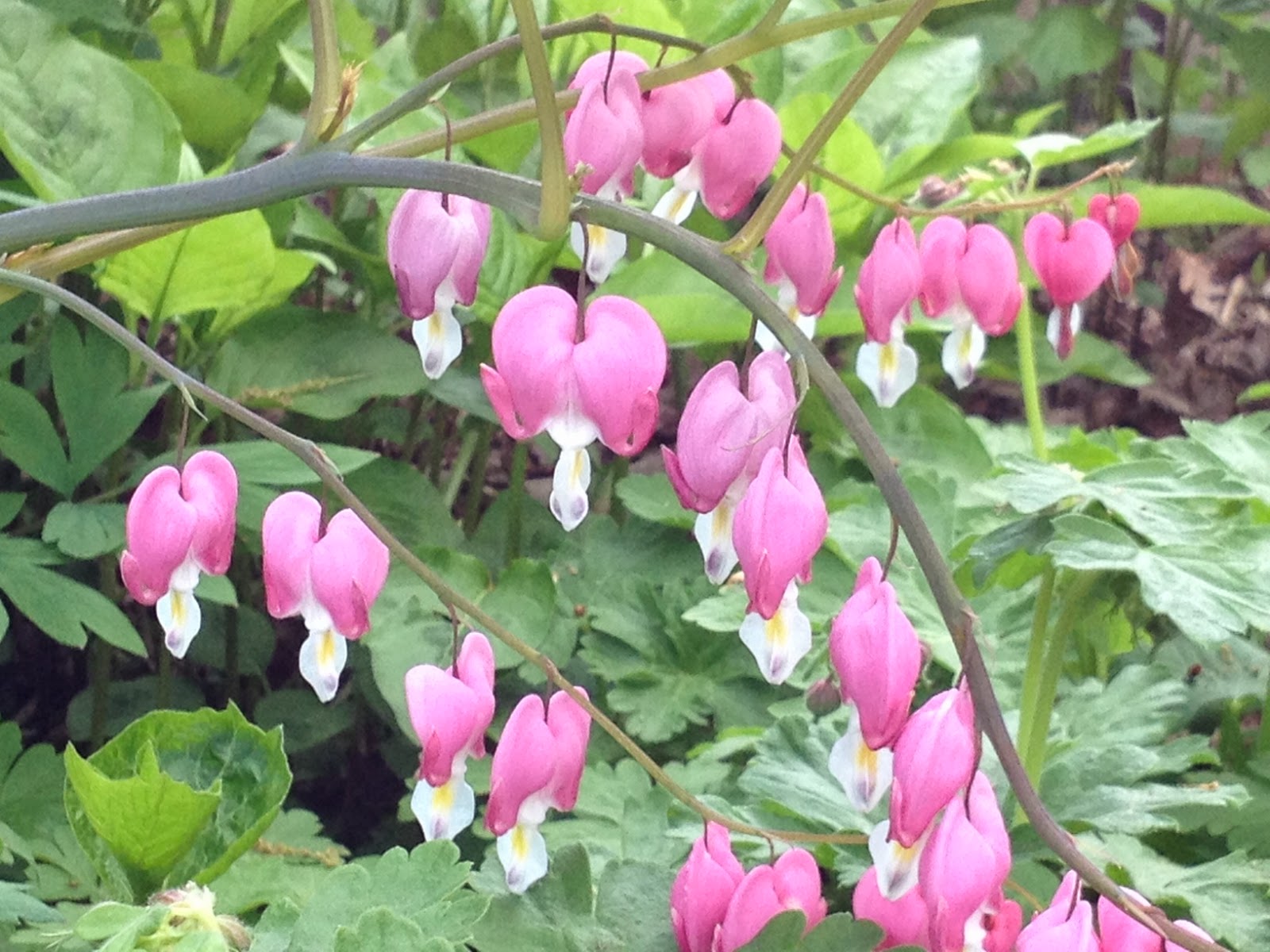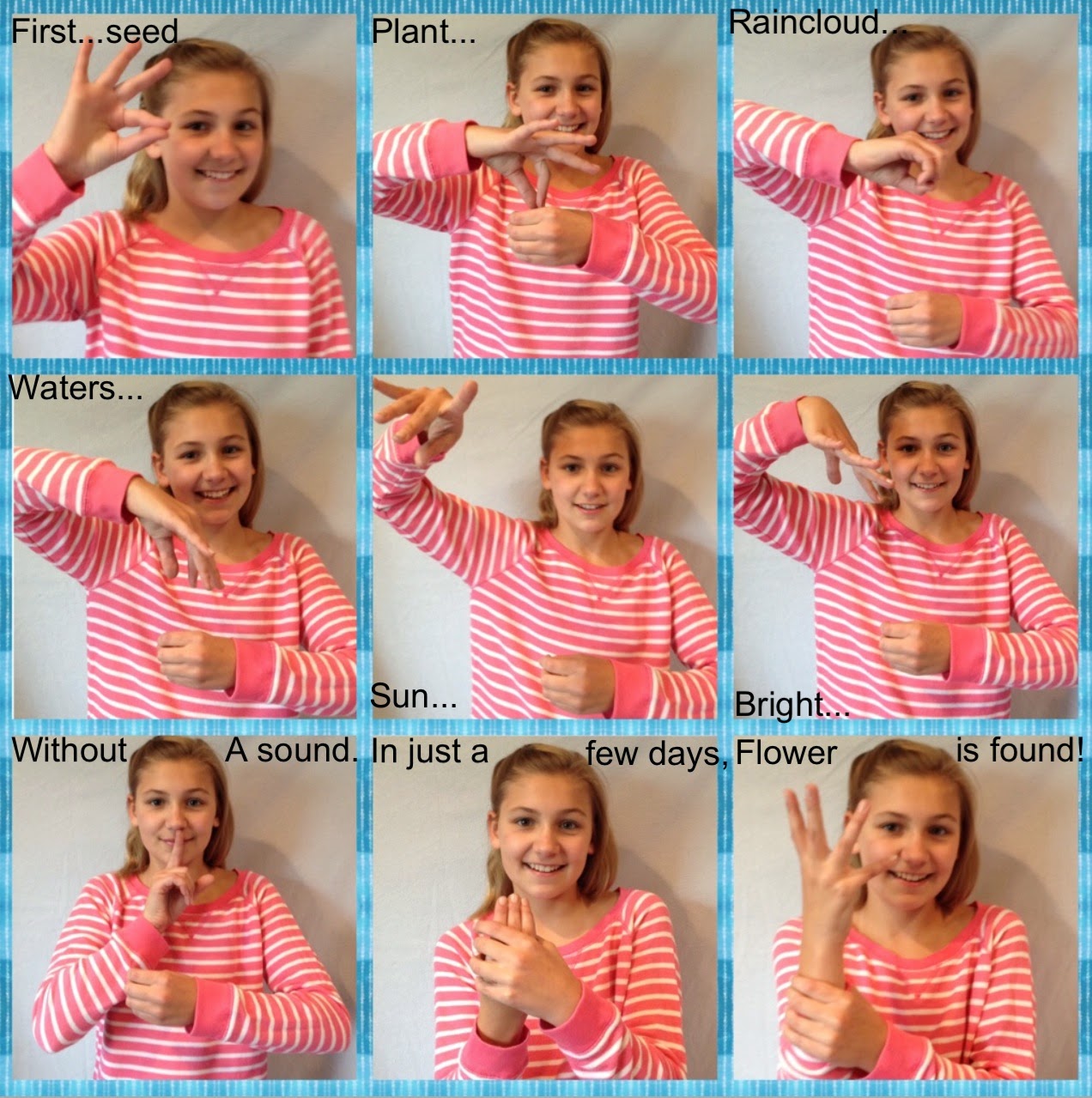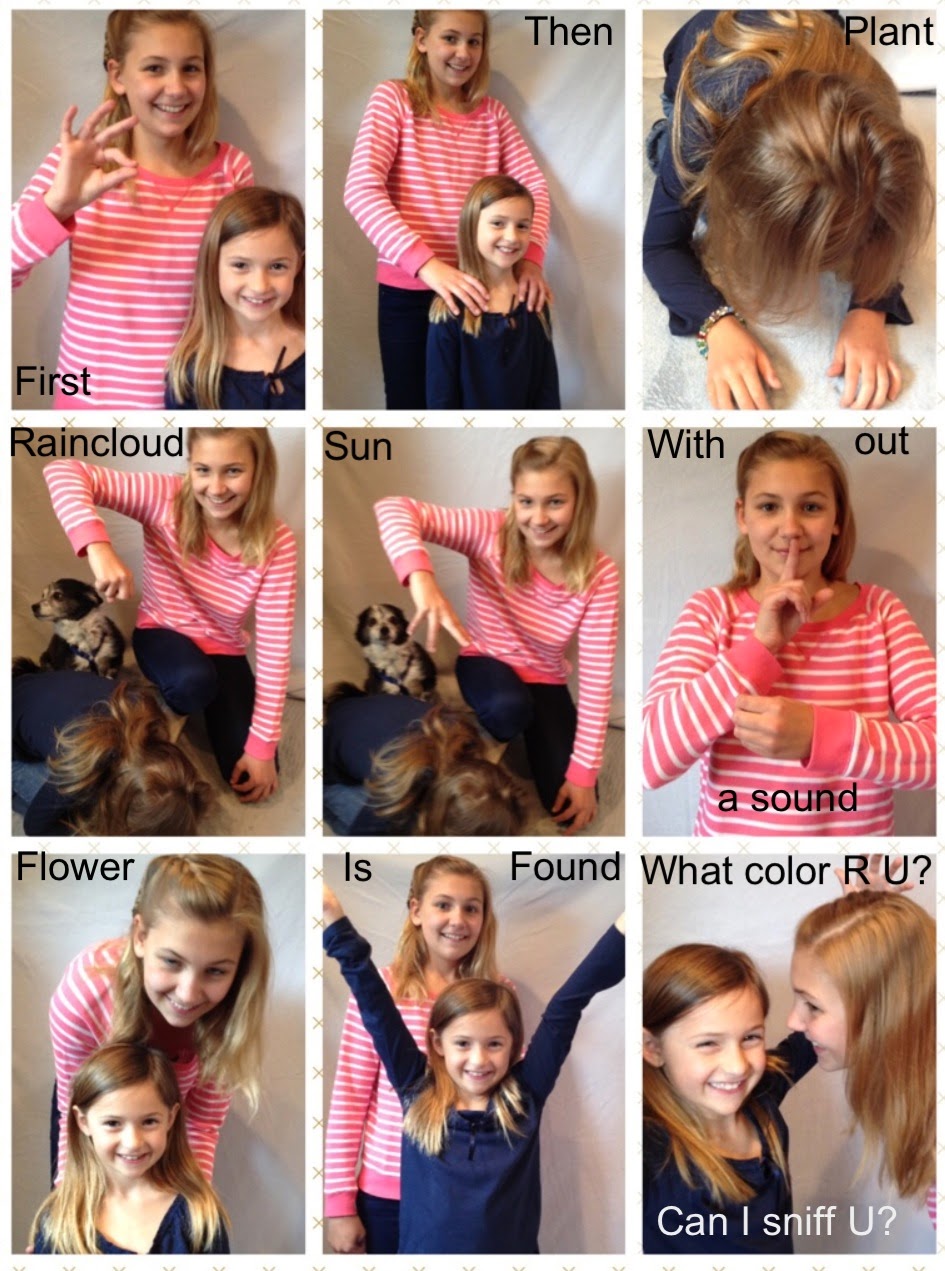 |
| ©2013 Brigid Finucane, Chicago Botanic Garden |
 |
| ©2014 Brigid Finucane |
The earth is finally awakening
and turning pretty again, with apple trees in full bloom, arches of
bleeding hearts, and lilacs starting to perfume the air. Inside, my
geranium cuttings are blossoming after a long winter’s hiatus, and the gardenia
has opened four buds today, with dozens
more on the way! It’s Spring!
This is the perfect time of year for bird songs, stories, and
dramatic play in the classrooms – made more magical by the appearance
of my plush
Audubon robin toy.
Press
the back and fat tummy (filled
with worms!) simultaneously, and the robin “sings” an authentic song! I encourage children to look for robins
outside in their yards, parks, and playground. All of a sudden,
bird becomes robin who nests amongst the apple
tree blossoms and whose eggs are the color of the sky.
TWO LITTLE BLACKBIRDS
 |
| ©2014 Brigid Finucane, Blackbirds in the garden! |
Of course, the robins have lots
of friends, including two little red-winged blackbirds, named Jack and Jill. My
Audubon blackbirds, are a bit shyer than the robin, and make their presence
known by calling to the children from the depths of the music bag. I ask, “Does anyone know who is making that sound?” No
one does. “Does it sound like a robin?”
No! Only a robin sounds like a robin! Out come the Audubon blackbirds, squawking
away! After introducing them to the group, the song is taught. There are many
different melodies to choose from,* but it works equally well as a chant
(spoken). Get your blackbird fingers ready!
Two
Little Blackbirds
Traditional
Two little blackbirds sitting on a hill,
One named Jack, the other named Jill.
Fly away Jack! Fly away
Jill!
Come back Jack! Come back
Jill!
*My melody. Made with Shadow Puppet app
Over the years I’ve added more
verses: Some shared by friends, others I’ve made up. The verses I like best are
(often) silly, composed of opposite pairs and have a kinesthetic element – but
that’s just me! Your kiddos will
guide you to the best choices for your
class. Invite them to offer their ideas, and make rhyming the first two lines a
class challenge! In the ideas below, the blackbirds are sitting on a…, playing in the…., flying in the…., etc., e.g.,
Two little blackbirds flying in a cloud. One was soft, the other was loud.
Two little blackbirds playing with their Dad. One was happy, the other
was sad.
snow
/ fast and slow snow / sang high, sang low
gate / early and late stick / healthy and sick
bend
/ beginning and end kite / heavy and light
IT’S
HARD TO STOP!
Two little blackbirds chatting by the pool, one
was hot, the other was cool.
driving in a car / near and far flying
into town / up and down
sitting on a wall / short and tall so
pretty to behold / shy and bold
chair / here and there wheelbarrow
/ wide and narrow
MORE IDEAS FROM TIM SESTON, CMN
Cool
note: Tim turns the blackbirds into penguins for the winter!
Two little blackbirds sliding down a hill,
one name won’t and one named will.
Spinning in the breeze / dance and freeze Sitting
on my shoulder/ hotter and colder
Sitting on my knee / you and me Sitting
on my pinky / fresh and stinky
 In addition to singing, we talk
about blackbirds’ habitat and look at pictures of them in the wild on my iPad.
Did you know the females are brown? My kiddos do, thanks to the iPad app, iBird Yard +, which offers fascinating and easy to navigate
support materials that include photos, bird songs/ calls directly in the app and a slideshow option with sound. Photographers are credited, which
is a very nice touch.
In addition to singing, we talk
about blackbirds’ habitat and look at pictures of them in the wild on my iPad.
Did you know the females are brown? My kiddos do, thanks to the iPad app, iBird Yard +, which offers fascinating and easy to navigate
support materials that include photos, bird songs/ calls directly in the app and a slideshow option with sound. Photographers are credited, which
is a very nice touch.
FIRST YOU TAKE A SEED
A song from the Hebrides dances
through my brain as I walk through my neighborhood in my self-appointed role as
a plant detective, applauding the appearance of buds and blossoms and sprouting
green spears:
For
day’s work and week’s work as I go up and down,
There
are many gardens, all about the town.
The song goes on to name
flowers and trees blooming in the in the gardens, and ends perfectly, in sync
with my thoughts:
I
have passed your railings, When you never knew.
To
people who have gardens I give my thanks to you.
 |
| ©2014 Brigid Finucane |
Yes, it’s time to plant a
garden – and I have just the poem to share, written by Susan
Salidor . It’s not only a surefire hit, but includes all the elements: earth,
water, sunshine and time!
First
You Take a Seed
©Susan
Salidor
First you take a seed Mime
holding a small seed.
And you plant it in the ground. Plant
the seed. Make sure to cover it.
Next a raincloud comes Make a
fist and move it across the “sky.”
And waters all around. Open
fingers and “rain”/wiggle fingers
over seed.
Then the sun shines brightly, Draw a
circle in the sky, open fingers to
“shine.”
Without a sound. Finger
to lips – “shhh!”
And in just a few days, Slowly
push one hand though fist like
plant growing.
A flower is found. Open and wiggle fingers for “a flower.”
 |
| ©2014 Brigid Finucane, Emma! |
This is a great partner game. One person plants, the other is the flower. Switch.
 |
| ©2014 Brigid Finucane, Emma & Kate (Sisters)! |
RAIN & CRESCENDO
RAINSTORMS
Spring in the Midwest means
rain, rain and more rain! Rain everywhere -
but not on me!
Rain On the Green Grass
(Traditional)
Rain on the green grass, Lower both hands in stages, with fingers apart.
Rain on the trees, Lift arms like branches on either side of body.
OR Tree sign: Arm vertical, open hand twists. Elbow rests on opposite hand.
Rain on the rooftops, Make shape of house, starting with peak of roof.
But not on me! Point to your own self with index finger.
 |
| ©2014 Brigid Finucane, Briana Hornsby (daughter)! |
Extensions:
1) Vocal echoes with
comparatives.
Ask students to echo. Draw from high/low, piano/forte, staccato/legato, fast/slow, singing/speaking voices.
Each phrase can be done a different way.
2) Beat & rhythm.
Clap or walk the beat (“feet to
the beat”) while reciting the chant, then clap the rhythm.
3) Half and half.
While standing with a partner,
rock the beat for the first half
of the chant, and pat the
rhythm (“rhythm hands”) with your partner for the second half Be gentle! There
are no trips to the hospital in music class!
 |
| ©2013 Brigid Finucan |
4) Drums, Please!
Play the chant’s rhythm on a
gathering drum, buffalo drums or nested frame drums,* phrase by phrase. Older
children can try chanting and playing the rhythm all the way through without
echoing. This is great syllabication practice! *See the Percusssion
Discussion below for simple ideas about introducing drums to your classroom.*
 |
| ©2013 Brigid Finucane |
5) Crescendo Rainstorm!
After saying and playing the chant’s rhythm, finish with a crescendo storm! A crescendo is when sound gradually increases from soft (piano) to loud (forte). First practice
with hands on the room’s carpet, then try it with drums. Start with one finger
on each hand, then gradually add more until all fingers and both hands are engaged. Crescendo!!! It’s
also great fun to introduce, then say, the words pianissimo (very soft) and
fortissimo (very loud) in Italian,
the language of music. If young children can casually tell me, “My parents drink cappuccino,” they can
also say fortissimo!
6) Crescendo circle.
Hold hands in a small circle.
With feet to the beat, chant Rain On the
Green Grass very softly (pianissimo).
Repeat, taking a small step backwards, and recite the chant a bit louder. With
each repetition, the circle gets a bit larger and the volume a bit louder,
until finally, the circle is fully extended and the volume level has reached fortissimo (very loud). Crescendo!
Drums are exciting! Minimize the potential for chaos by
taking time to introduce the drums and demonstrate sounds that can be made.
Discuss appropriate use, starting and stopping together, etc.
I have found success with
bringing in several nested drums and placing them flat on the floor so kiddos
can use alternating hands when
they play rhythms and the crescendo
rainstorm. Groups take turn playing. When one group finishes the sequence,
the next group takes their place.
Sit one to three children at a drum, depending on the sizes
of the drums, children and class! Consider using a ritual like the described
below, so that you can easily check that no instruments are being assaulted and
everyone is having fun. I start
with a ritual every time the drums come to class. The players echo everything I
say, and mirror my playing.
Ritual
Hand’s
up! (Said after every phrase)
Hello,
drum! (Hit drum, using the word’s rhythm)
Give it
a scratch! (Scratch drumhead gently. Experiment with sound.)
Now pet
the drum. (Rub the drumhead
gently. Experiment with sound.)
Good
drum! (Hit drum, using the word’s rhythm.)
Bits and Pieces
The Children’s Music Network's listserv is bursting with
wonderful ideas for celebrating the season. Here are a few of my favorites:
 |
| ©2013 Brigid Finucane |
Liz Buchannan’s
version of Two Little Blackbirds / Robins
connecting traditional songs to
literacy learning.
Trees need the Sun (make a circle
with your arms for the sun),
Trees need the rain (use your
fingers to show rain),
Trees need the earth (touch the
ground with your hands),
It's always been that way.
© 2012 Rock’n’Rainbow Music Publishing/Rainbow Songs Inc.
And last, but not least, Debbie Carroll’s “Simply Beautiful” version
of The Tree Song by Lorraine Lee Hammond, a perfect song about an apple tree through the seasons. "...in Springtime the blossoms grow on me. They open, they open." It makes my
heart sing.
And in the end...how did I use my iPad in the activities and blog creation, anyhow?
 |
| ©2014 Brigid Finucane |
I am continually inspired by the Children’s Music Network (CMN) community. an international group of socially conscious musicians, educators, librarians, families, songwriters and good people, who “celebrate the positive power of music in the lives of children by sharing songs, exchanging ideas, and creating community.” Please visit CMN, and find a gathering in your region.
©2014 Brigid Finucane * 847-213-0713 * gardengoddess1@comcast.net
http://prekandksharing.blogspot.com
http://brigidfinucane.blogspot.com
@booksinger1
Blog History










